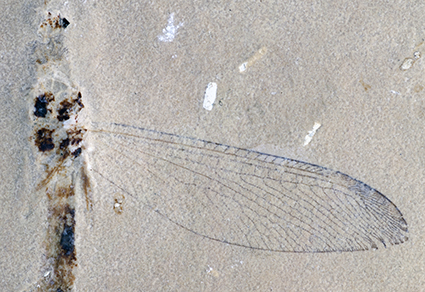Abstract
Olindanymphes? headsi sp. nov. (Neuroptera: Nymphidae) is described from the late Aptian (Lower Cretaceous) Crato Formation of Brazil. Its hindwing is unique in the family by the presence of the few-pectinate both CuA and CuP, each with two to three branches. The few-pectinate CuA in the hindwing is a derived condition known only in three Early Cretaceous species, including the new species.
References
Archibald, S.B. & Makarkin, V.N. (2020) A new genus and species of split-footed lacewings (Neuroptera) from the early Eocene of western Canada and revision of the subfamily affinities of Mesozoic Nymphidae. Canadian Entomologist, 152, 269–287. https://doi.org/10.4039/tce.2020.10
Archibald, S.B., Makarkin, V.N. & Ansorge, J. (2009) New fossil species of Nymphidae (Neuroptera) from the Eocene of North America and Europe. Zootaxa, 2157 (1), 59–68. https://doi.org/10.11646/zootaxa.2157.1.4
Breitkreuz, L.C.V., Winterton, S.L. & Engel, M.S. (2017) Wing tracheation in Chrysopidae and other Neuropterida (Insecta): A resolution of the confusion about vein fusion. American Museum Novitates, 3890, 1–44. https://doi.org/10.1206/3890.1
Carpenter, F.M. (1929) A Jurassic neuropteran from the lithographic limestone of Bavaria. Psyche, 36, 190–194. https://doi.org/10.1155/1929/12134
Haase, E. (1890) Bemerkungen zur Palaeontologie der Insecten. Neues Jahrbuch für Mineralogie, Geologie und Paläontologie, 2, 1–33.
Linnaeus, C. (1758) Systema naturae per regna tria naturae secundum classes, ordines, genera, species, cum characteribus, differentiis, synonymis, locis. 10th Edition. Vol. 1. Salvii, Holmiae, 824 pp. https://doi.org/10.5962/bhl.title.542
Makarkin, V.N. (1990a) New lacewings (Neuroptera) from the Late Cretaceous of Asia. In: Akimov, I.A. (Chief Ed.), News of faunistics and systematics. Naukova Dumka, Kiev, pp. 63–68. [in Russian]
Makarkin, V.N. (1990b) Baissoleon cretaceus gen. and sp. nov. Fossil Neuroptera from the Lower Cretaceous of Baisa, East Siberia. 2. Nymphitidae. Annales de la Société Entomologique de France, Neue Folge, 26, 125–126.
Makarkin, V.N., Heads, S.W. & Wedmann, S. (2017) Taxonomic study of the Cretaceous lacewing family Babinskaiidae (Neuroptera: Myrmeleontoidea: Nymphidoidae), with description of new taxa. Cretaceous Research, 78, 149‒160. https://doi.org/10.1016/j.cretres.2017.06.007
Martins-Neto, R.G. (2005) New Neuroptera from Crato Formation, Lower Cretaceous, Araripe Basin, Northeast Brazil. Gaea, 1, 5–10.
Myskowiak, J., Huang, D., Azar, D., Cai, C.Y., Garrouste, R. & Nel, A. (2016) New lacewings (Insecta, Neuroptera, Osmylidae, Nymphidae) from the Lower Cretaceous Burmese amber and Crato Formation in Brazil. Cretaceous Research, 59, 214‒227. https://doi.org/10.1016/j.cretres.2015.10.029
New, T.R. (1982) A revision of the Australian Nymphidae (Insecta: Neuroptera). Australian Journal of Zoology, 29, 707–750. https://doi.org/10.1071/ZO9810707
New, T.R. (1985) A second species of Nymphidae (Neuroptera) from Papua New Guinea. Neuroptera International, 3, 187–189.
New, T.R. (1986) A new Australian species of Nymphidae (Neuroptera). Journal of the Australian Entomological Society, 25, 329–331. https://doi.org/10.1111/j.1440-6055.1986.tb01125.x
New, T.R. (1988) Nymphidae (Insecta: Neuroptera) from New Guinea. Invertebrate Taxonomy, 1, 807–815. https://doi.org/10.1071/IT9870807
Oswald, J.D. (1993) Revision and cladistic analysis of the world genera of the family Hemerobiidae (Insecta: Neuroptera). Journal of the New York Entomological Society, 101, 143–299.
Oswald, J.D. (1997) Review of the sejunctus species group of the split-footed lacewing genus Osmylops Banks (Neuroptera: Nymphidae), with remarks on the functional morphology of teminalic coupling. Australian Journal of Entomology, 36, 351–358. https://doi.org/10.1111/j.1440-6055.1997.tb01485.x
Oswald, J.D. (1998) Osmylops Banks (Neuroptera: Nymphidae): generic review and revision of the armatus species group. Journal of Neuropterology, 1, 79–108.
Panfilov, D.V. (1980) New representatives of lacewings (Neuroptera) from the Jurassic of Karatau. In: Dolin, V.G., Panfilov, D.V., Ponomarenko, A.G., Pritykina, L.N., Fossil insects of the Mesozoic. Naukova Dumka, Kiev, pp. 82–111. [in Russian]
Ponomarenko, A.G. (1992) Neuroptera (Insecta) from the Lower Cretaceous of Transbaikalia. Paleontologicheskii Zhurnal, 1992, 43–50. [in Russian; English translation: Paleontological Journal, 26 (3), 56–66]
Rambur, J.P. (1842) Histoire Naturelle des Insectes, Nevropteres. Fain et Thunot, Paris, 534 pp.
Ren, D. & Engel, M.S. (2007) A split-footed lacewing and two epiosmylines from the Jurassic of China (Neuroptera). Annales Zoologici, 57, 211–219.
Shi, C.F., Makarkin, V.N., Yang, Q., Archibald, S.B. & Ren, D. (2013) New species of Nymphites Haase (Neuroptera: Nymphidae) from the Middle Jurassic of China, with a redescription of the type species of the genus. Zootaxa, 3700 (3), 393‒410. https://doi.org/10.11646/zootaxa.3700.3.4
Shi, C.F., Winterton, S.L. & Ren, D. (2015) Phylogeny of split-footed lacewings (Neuroptera, Nymphidae), with descriptions of new Cretaceous fossil species from China. Cladistics, 31, 455–490. https://doi.org/10.1111/cla.12104
Westwood, J.O. (1854) Contributions to fossil entomology. Quarterly Journal of the Geological Society of London, 10, 378–396. https://doi.org/10.1144/GSL.JGS.1854.010.01-02.43
Weyenbergh, H. Jr. (1869) Sur les insectes fossiles du calcaire lithographique de la Bavière, qui se trouvent au Musée Teyler. Archives du Musée Teyler, Series 1, 2, 247–294. https://doi.org/10.5962/bhl.title.33087


